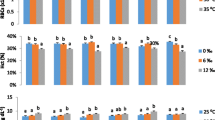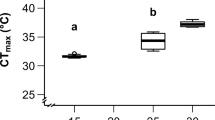Abstract
One year old, individually tagged Lake Inari Arctic charr, Salvelinus alpinus, were reared at three constant temperatures, 10.3°C, 14.1°C and 18.1°C, over four weeks. Blood samples were collected from a group of unstressed fish after the cultivation period at the same time as another group of fish were subjected to acute handling stress treatment (2 min netting in air and 40 min (± 20 min) recovery period in water). Plasma cortisol, calcium, sodium, potassium and chloride concentrations were measured on both groups. To study the effect of minor daily temperature fluctuations on the stress response of Arctic charr, two additional daily fluctuating temperature (14 ± 1°C, 18 ± 1°C) treatments were established. The samples were taken in the same manner as those in the constant temperature treatments. Growth was fastest at 10.3–14.1°C and clearly lower at 18.1°C. Pre-stress plasma cortisol levels were low but increased slightly with increasing temperature. After stressor treatment, the cortisol concentrations of Arctic charr were clearly higher in all temperature treatments but there were no significant differences in plasma cortisol concentrations among temperatures. Plasma calcium levels increased during the stress treatment but temperature did not modulate this effect. The plasma potassium concentrations declined at 14.1–18.1°C after acute stress but the response was not affected by temperature within this range. The concentrations of sodium and chloride were unaffected by acute stress. Temperatures of 10.3–18.1°C and fluctuating temperature treatments had no influence on any plasma ion concentrations. Arctic charr were able to maintain the plasma ion concentrations in fresh water at 10.3–18.1°C and after acute stress treatment. Results indicate that the optimum temperature for growth of Arctic charr has little to do with the plasma ion concentrations or the ability to maintain those concentrations after short-term stress. The plasma cortisol responses further indicate that the optimum temperature for growth of Arctic charr is not related to the suppressed ability to react to an acute handling stressor. Temperature fluctuations did not cause significant differences in cortisol levels when compared with constant temperatures.
Similar content being viewed by others
References cited
Alderdice, D.F. 1976. Some concepts and descriptions of physiological tolerance: rate-temperature curves of poikilotherms as transects of response surfaces. J. Fish. Res. Board Can. 33: 135–142.
Barton, B.A. 1997. Stress in finfish: past, present and future - a historical perspective. pp. 1–34. In: G.K. Iwama, A.D. Pickering, J.P. Sumpter & C.B Schreck (ed.) Fish Stress and Health in Aquaculture, Society for Experimental Biology Seminar Series 62, Cambridge University Press, Cambridge.
Barton, B.A. 2000. Salmonid fishes differ in their cortisol and glucose responses to handling and transport stress. N. Amer. J. Fish. Aquacult. 62: 12–18.
Barton, B.A. & G.K. Iwama. 1991. Physiological changes in fish from stress in aquaculture with emphasis on the response and effects off corticosteroids. Ann. Rev. Fish Diseases 1: 3–26.
Barton, B.A. & C.B. Schreck. 1987. Influence of acclimation temperature on interrenal and carbohydrate stress responses in juvenile chinook salmon (Oncorhynchus tshawytscha). Aquaculture 62: 299–310.
Brett, J.R. 1976. Scope for metabolism and growth of sockeye salmon, Oncorhynchus nerka, and some related energetics. J. Fish. Res. Board Can. 33: 307–313.
Brett, J.R. & T.D.D. Groves. 1979. Physiological energetics. pp. 280–344. In: W.S. Hoar, D.J. Randall & J.R Brett (ed.) Fish Physiology, Volume 8, Academic Press, New York.
Burton, R.F. 1986. Review - ionic regulation in fish: the influence of acclimation temperature on plasma composition and apparent set points. Comp. Biochem. Physiol. 85A: 23–28.
Davis, K.B., M.A. Suttle & N.C. Parker. 1984. Biotic and abiotic influences on corticosteroid hormone rhythms in channle catfish. Trans. Amer. Fish. Soc. 113: 414–421.
Flik, G. & S.F. Perry. 1989. Cortisol stimulates whole body uptake and the branchial calcium pump in freashwater rainbow trout. J. Endocrinol. 120: 75–82.
Hokanson, K.E.F., C.F. Kleiner & T.W. Thorslund. 1977. Effects of constant temperatures and diel temperature fluctuations on specific growth and mortality and yield of juvenile rainbow trout, Salmo gairdneri. J. Fish. Res. Board Can. 34: 639–648.
Jobling, M., E.H. Jørgensen, A.M. Arnesen & E. Ringø . 1993. Feeding, growth, and environmental requirements of arctic char: a review of aquaculture potential. Aquacult. Int. 1: 20–46.
Larsson, S. & I. Berglund. 1998. Growth and food consumption of O+ Arctic charr fed pelleted or natural food at six temperatures. J. Fish Biol. 52: 230–242.
Laurent, P. & S.F. Perry. 1989. Effects of cortisol on gill chloride cell morphology and ionic uptake in the freshwater trout. Cell Tissue Res. 250: 429–442.
Lyytikäinen, T. & M. Jobling. 1998. The effect of temperature fluctuations on oxygen consumption and ammonia excretion of underyearling Lake Inari arctic charr (Salvelinus alpinus (L.)). J. Fish Biol. 52: 1186–1198.
Lyytikäinen, T. & M. Jobling. 1999a. The effects of temperature, temperature shift and temperature fluctuation on daily feed intake, growth and proximate composition of underyearling Lake Inari Arctic charr (Salvelinus alpinus (L.)). Nordic J. Freshwat. Res. 74: 87–94.
Lyytikäinen, T. & M. Jobling. 1999b. Effects of thermal regime on energy and nitrogen budgets of an early juvenile Arctic charr, Salvelinus alpinus, from Lake Inari. Env. Biol. Fish. 54: 219–227.
Lyytikäinen, T., J. Koskela & I. Rissanen. 1997a. The influence of temperature on growth and proximate body composition of underyearling Lake Inari Arctic charr (Salvelinus alpinus (L.)). J. Appl. Ichthyol. 13: 191–194.
Lyytikäinen, T., J. Koskela & I. Rissanen. 1997b. Thermal resistance and upper lethal temperatures of underyearling Lake Inari Arctic charr. J. Fish Biol. 51: 515–525.
Madsen, S.S. 1990. Enhanced hypo-osmoregulatory response to growth hormone after cortisol treatment in immature rainbow trout, Salmo gairdneri. Fish Physiol. Biochem. 8: 271–281.
Mazeaud, M. & F. Mazeaud. 1981. Adenergic responses to stress in fish. pp. 49–75. In: A.D. Pickering (ed.) Stress and Fish, Academic Press, New York.
McDonald, G. & L. Milligan. 1997. Ionic, osmotic and acid-base regulation in stress. pp. 119–144. In: G.K. Iwama, A.D. Pickering, J.P. Sumpter & C.B. Schreck (ed.) Fish, Stress and Health in Aquaculture, Society for Experimental Biology Seminar Series 62, Cambridge University Press, Cambridge.
Mommsen, T.P., M.M. Vijayan & T.W. Moon. 1999. Cortisol in teleosts: dynamics, mechanisms of action, and metabolic regulation. Rev. Fish Biol. Fisheries 9: 211–268.
Poslethwaite, E.K. & D.G. McDonald. 1995. Mechanisms of Na+ and Cl+ regulation in freswater-adapted rainbow trout (Oncorhynchus mykiss) during excercise and stress. J. Exp. Biol. 198: 295–304.
Swift, D.R. 1964. The effect of temperature and oxygen on the growth rate of the Windermere char (Salvelinus alpinus willughbii). Comp. Biochem. Physiol. 12: 179–183.
Strange, R.J. 1980. Acclimation temperature influences cortisol and glucose concentrations in stressed channel catfish. Trans. Amer. Fish Soc. 109: 298–303.
Strange, R.J., C.B. Schreck & J.T. Golden. 1977. Corticoid stress responses to handling and temperature in salmonids. Trans. Amer. Fish. Soc. 106: 213–217.
Thomas, R.E., J.A. Gharrett, M.G. Carls, S.D. Rice, A. Moles & S. Korn. 1986. Effects of fluctuating temperature on mortality, stress, and energy reserves of juvenile coho salmon. Trans. Amer. Fish. Soc. 115: 52–59.
Author information
Authors and Affiliations
Rights and permissions
About this article
Cite this article
Lyytikäinen, T., Pylkkö, P., Ritola, O. et al. The Effect of Acute Stress and Temperature on Plasma Cortisol and ion Concentrations and Growth of Lake Inari Arctic Charr, Salvelinus Alpinus . Environmental Biology of Fishes 64, 195–202 (2002). https://doi.org/10.1023/A:1016017822700
Issue Date:
DOI: https://doi.org/10.1023/A:1016017822700




